A) has perfect information about consumer demand.
B) operates in a competitive market.
C) faces a downward-sloping demand curve.
D) is regulated by the government.
F) A) and C)
Correct Answer

verified
Correct Answer
verified
Multiple Choice
Consider a profit-maximizing monopoly pricing under the following conditions.The profit-maximizing price charged for goods produced is $12.The intersection of the marginal revenue and marginal cost curves occurs where output is 10 units and marginal cost is $6.The socially efficient level of production is 12 units.The demand curve and marginal cost curves are linear.What is the value of the deadweight loss created by the monopolist?
A) $4
B) $6
C) $12
D) $16
F) None of the above
Correct Answer

verified
Correct Answer
verified
Multiple Choice
Table 15-6
A monopolist faces the following demand curve:
 -Refer to Table 15-6.What is the marginal revenue from the sale of the 2nd unit?
-Refer to Table 15-6.What is the marginal revenue from the sale of the 2nd unit?
A) $-3
B) $3
C) $9
D) $24
F) A) and C)
Correct Answer

verified
Correct Answer
verified
True/False
In a monopoly market,the socially efficient quantity of output is typically higher than the profit-maximizing quantity of output for the monopolist.
B) False
Correct Answer

verified
Correct Answer
verified
Multiple Choice
Perfect price discrimination describes a situation in which the monopolist
A) knows the exact willingness to pay of each of its customers.
B) charges exactly two different prices to exactly two different groups of customers.
C) maximizes consumer surplus.
D) experiences a zero economic profit.
F) A) and D)
Correct Answer

verified
Correct Answer
verified
Multiple Choice
For a long while,electricity producers were thought to be a classic example of a natural monopoly.People held this view because
A) the average cost of producing units of electricity by one producer in a specific region was lower than if the same quantity were produced by two or more producers in the same region.
B) the average cost of producing units of electricity by one producer in a specific region was higher than if the same quantity were produced by two or more produced in the same region.
C) the marginal cost of producing units of electricity by one producer in a specific region was higher than if the same quantity were produced by two or more producers in the same region.
D) electricity is a special non-excludable good that could never be sold in a competitive market.
F) A) and C)
Correct Answer

verified
Correct Answer
verified
Multiple Choice
Figure 15-16
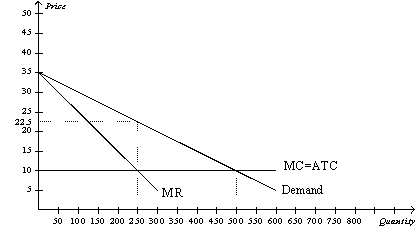 -Refer to Figure 15-16.If there are no fixed costs of production,monopoly profit with perfect price discrimination equals
-Refer to Figure 15-16.If there are no fixed costs of production,monopoly profit with perfect price discrimination equals
A) $1.
B) $1,562.5.
C) $3,125.
D) $6,250.
F) C) and D)
Correct Answer

verified
Correct Answer
verified
True/False
One characteristic of a monopoly market is that the product is virtually identical to products produced by competing firms.
B) False
Correct Answer

verified
Correct Answer
verified
Multiple Choice
A firm cannot price discriminate if
A) its has declining marginal revenue.
B) it operates in a competitive market.
C) buyers only reveal the price they are willing to pay for the product.
D) it has a constant marginal cost.
F) A) and C)
Correct Answer

verified
Correct Answer
verified
Multiple Choice
Figure 15-2
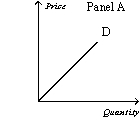
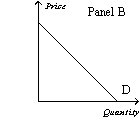
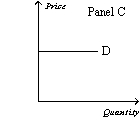
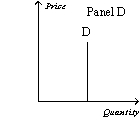 -Refer to Figure 15-2.Which of the following statements is correct?
-Refer to Figure 15-2.Which of the following statements is correct?
A) Panel C represents the typical demand curve for a perfectly competitive firm, and Panel B represents the typical demand curve for a monopoly.
B) Panel B represents the typical demand curve for a perfectly competitive firm, and Panel C represents the typical demand curve for a monopoly.
C) Panel A represents the typical demand curve for a perfectly competitive firm, and Panel B represents the typical demand curve for a monopoly.
D) Panel C represents the typical demand curve for a perfectly competitive firm, and Panel D represents the typical demand curve for a monopoly.
F) A) and D)
Correct Answer

verified
Correct Answer
verified
Multiple Choice
For a monopolist,
A) average revenue is always greater than the price of the good.
B) marginal revenue is always less than the price of the good.
C) marginal cost is always greater than average total cost.
D) marginal revenue equals marginal cost at the point where total revenue is maximized.
F) B) and D)
Correct Answer

verified
Correct Answer
verified
Multiple Choice
Scenario 15-6 The concert promoters of a heavy-metal band, WeR2Loud, know that there are two types of concert-goers: die-hard fans and casual fans. For a particular WeR2Loud concert, there are 1,000 die-hard fans who will pay $150 for a ticket and 500 casual fans who will pay $50 for a ticket. There are 1,500 seats available at the concert venue. Suppose the cost of putting on the concert is $50,000, which includes the cost of the band, lighting, security, etc. -Refer to Scenario 15-6.How much additional profit can the concert promoters earn by charging each customer their willingness to pay relative to charging a flat price of $150 per ticket?
A) $25,000
B) $50,000
C) $75,000
D) $100,000
F) B) and C)
Correct Answer

verified
Correct Answer
verified
Multiple Choice
The deadweight loss that arises from a monopoly is a consequence of the fact that the monopoly
A) quantity is lower than the socially-optimal quantity.
B) price equals marginal revenue.
C) price is the same as average revenue.
D) earns positive profits.
F) A) and D)
Correct Answer

verified
Correct Answer
verified
Multiple Choice
The economic inefficiency of a monopolist can be measured by the
A) number of consumers who are unable to purchase the product because of its high price.
B) excess profit generated by monopoly firms.
C) poor quality of service offered by monopoly firms.
D) deadweight loss.
F) A) and D)
Correct Answer

verified
Correct Answer
verified
Multiple Choice
Figure 15-16
 -Refer to Figure 15-16.If the monopoly firm perfectly price discriminates,then the deadweight loss amounts to
-Refer to Figure 15-16.If the monopoly firm perfectly price discriminates,then the deadweight loss amounts to
A) $0.
B) $1,562.50.
C) $3,125.
D) $6,250.
F) B) and C)
Correct Answer

verified
Correct Answer
verified
Multiple Choice
Table 15-8
The following table provides information on the price, quantity, and average total cost for a monopoly.
 -Refer to Table 15-8.What is the additional cost to the firm when the monopolist lowers the price from $18 to $12?
-Refer to Table 15-8.What is the additional cost to the firm when the monopolist lowers the price from $18 to $12?
A) The firm saves $15.
B) $15
C) $30
D) $40
F) B) and C)
Correct Answer

verified
Correct Answer
verified
True/False
The three main sources of barriers to entry are monopoly resources,government regulation,and the firm's production process.
B) False
Correct Answer

verified
Correct Answer
verified
True/False
Government intervention is always preferable to doing nothing when reducing the social inefficiencies of monopoly.
B) False
Correct Answer

verified
Correct Answer
verified
Multiple Choice
Table 15-17
 -Refer to Table 15-17.If a monopolist faces a constant marginal cost of $5,how much output should the firm produce?
-Refer to Table 15-17.If a monopolist faces a constant marginal cost of $5,how much output should the firm produce?
A) 3 units
B) 4 units
C) 5 units
D) 6 units
F) B) and D)
Correct Answer

verified
Correct Answer
verified
Multiple Choice
Round-trip airline tickets are usually cheaper if you stay over a Saturday night before you fly back.What is the reason for this price discrepancy?
A) Airlines are practicing imperfect price discrimination to raise their profits.
B) Airlines charge a different rate based on the different nature of peoples' travel needs.
C) Airlines are attempting to charge people based on their willingness to pay.
D) All of the above are correct.
F) B) and C)
Correct Answer

verified
Correct Answer
verified
Showing 421 - 440 of 526
Related Exams